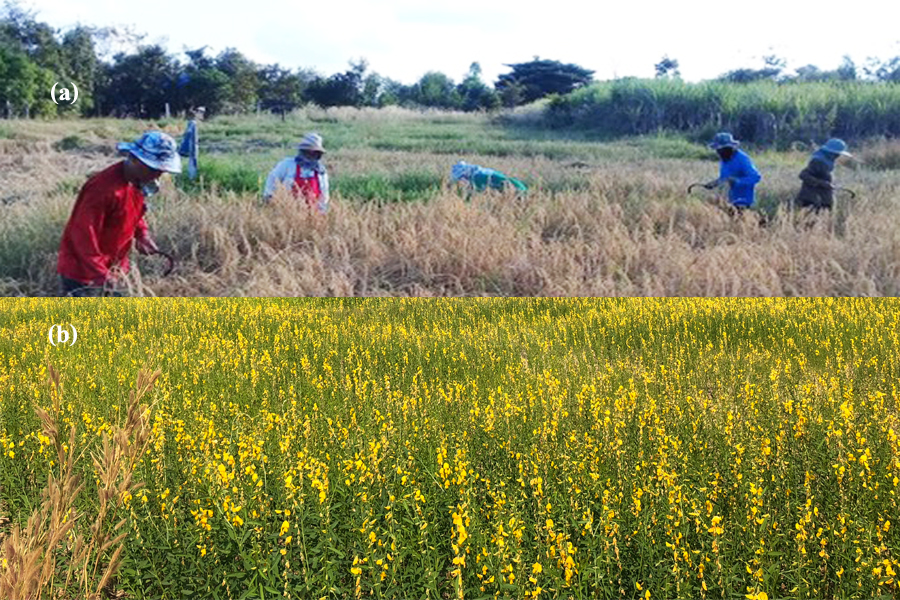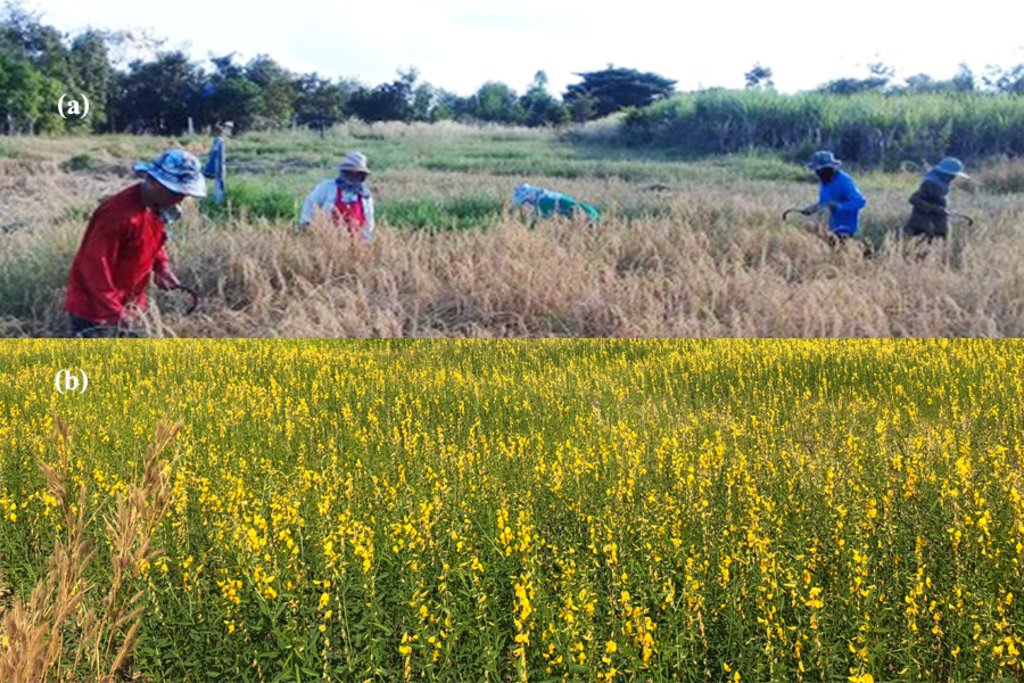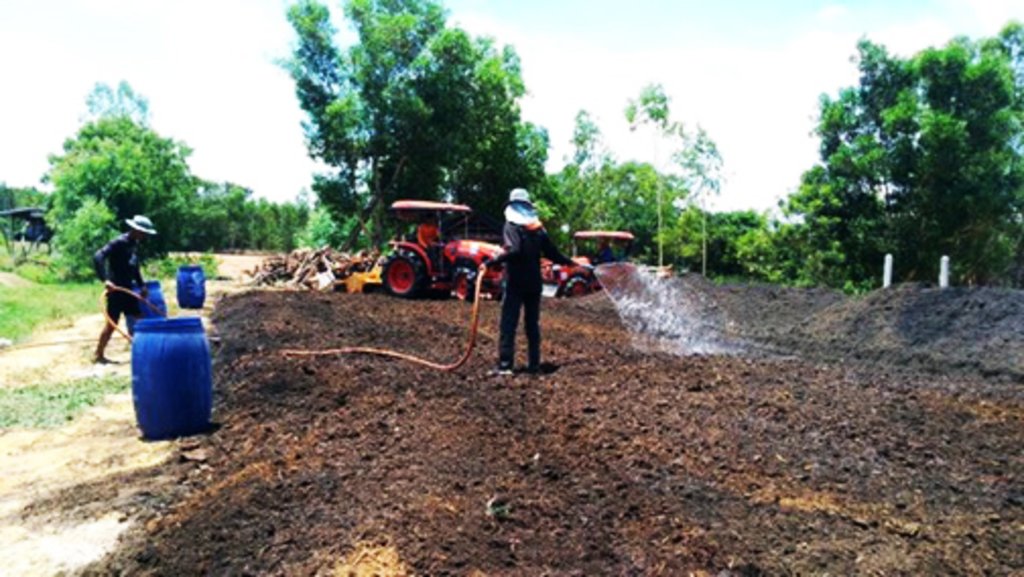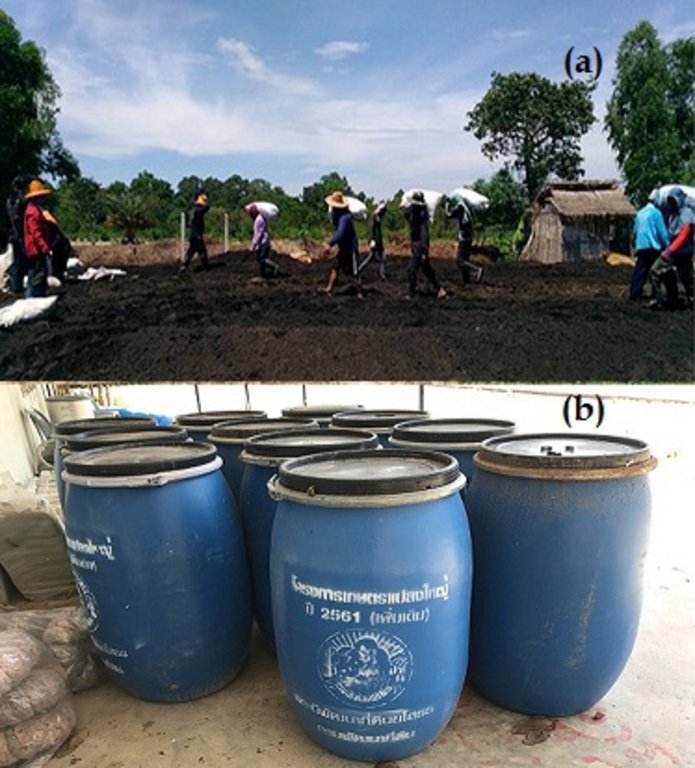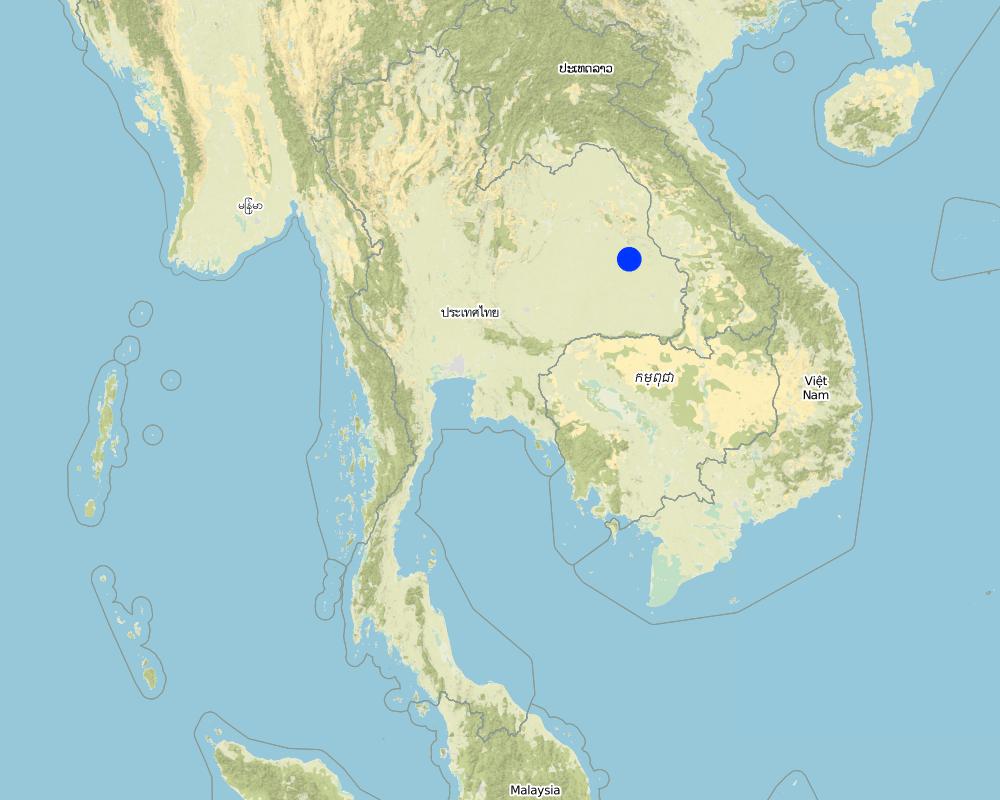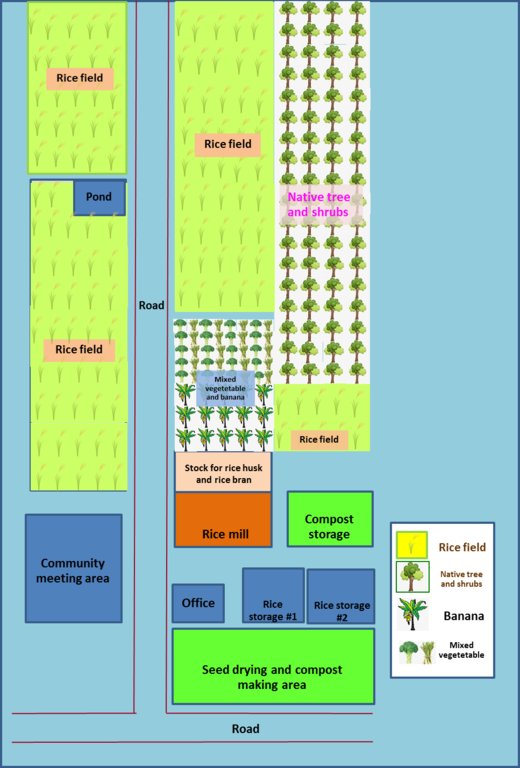Use of Organic Fertilizers for Organic Crop Pproduction on Infertile Soil [泰国]
- 创建:
- 更新:
- 编制者: Suwannapa B00njongrak
- 编辑者: –
- 审查者: Rima Mekdaschi Studer, Samran Sombatpanit
technologies_4176 - 泰国
查看章节
全部展开 全部收起1. 一般信息
1.2 参与该技术评估和文件编制的资源人员和机构的联系方式
关键资源人
SLM专业人员:
Namsai Yuthasong
SLM专业人员:
Suthakum Ratana
泰国
SLM专业人员:
Kaoya Putchanee
泰国
national consultant:
Arunin Somsri
Land Development Department
泰国
有助于对技术进行记录/评估的项目名称(如相关)
Decision Support for Mainstreaming and Scaling out Sustainable Land Management (GEF-FAO / DS-SLM)有助于对技术进行记录/评估的机构名称(如相关)
Land Development Department LDD (Land Development Department LDD) - 泰国1.3 关于使用通过WOCAT记录的数据的条件
编制者和关键资源人员接受有关使用通过WOCAT记录数据的条件。:
是
1.4 所述技术的可持续性声明
这里所描述的技术在土地退化方面是否存在问题,导致无法被认为是一种可持续的土地管理技术?:
否
注释:
This is the main technology supporting organic farming which is the process accepted by the whole world because it concerns the food stability and security.
1.5 参考关于SLM方法(使用WOCAT记录的SLM方法)的调查问卷
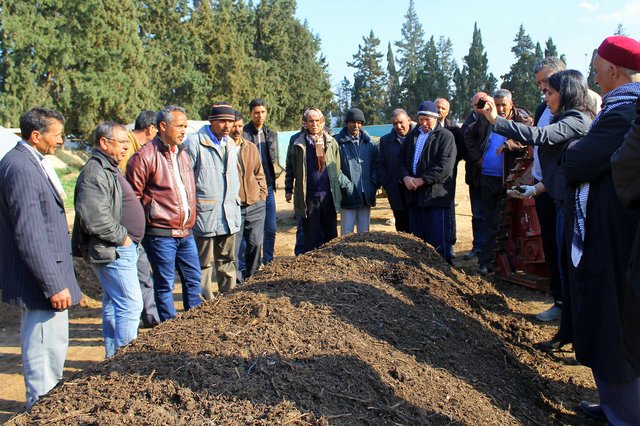
Immense demande de valorisation des déchets et amélioration … [突尼斯]
Une immense demande de la technique du compostage comme une solution environmentale et écologique pour la gestion des déchets et un traitement obligatoire des dechets organiques en agriculture biologique.
- 编制者: Donia Mühlematter
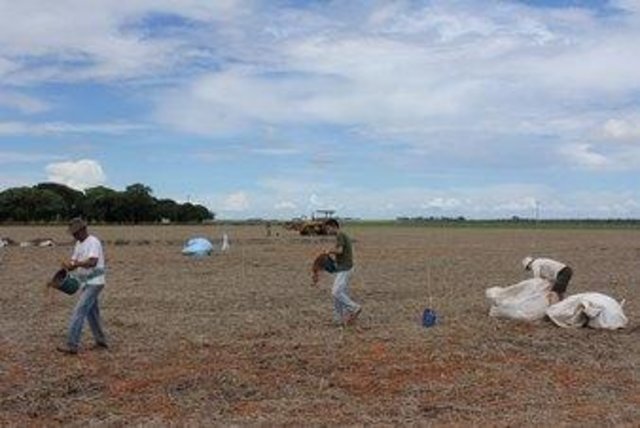
Enrichment of Tropical Agricultural Soil with Organic Matter [巴西]
Enrichment of tropical agicultural soils with local available organic matter in the cerrado agroscape, Brazil.
- 编制者: Luisa F. Vega
2. SLM技术的说明
2.1 技术简介
技术定义:
The organic farming was initiated by a group of Yasothon farmers since 1989 to produce organic rice and vegetables. The organic fertilizers used are the compost made from farm products and animal dungs, bio-fermented liquid from kitchen wastes and crotalaria as green manure.
2.2 技术的详细说明
说明:
Organic farming has become a national agenda with cross collaboration among government organizations concerned, local community administration, private sectors and farmers. This technology has scaled up to 253 farmers on 6,000 rai (6.25 rai = 1 ha) at Ban Sokkompoon, Naso Sub-district, Kutchum District, Yasothon Province. The information has been received from Mr. Man Samsee, chief of the community and a farmer himself. The organic fertilizers used in the farmers’ fields are the compost from farm products and animal dungs, bio-fermented liquid from kitchen wastes, fermented liquid from neem (Azadirachta indica) for pest control, and green manure from Crotalaria juncia. The crops grown have been rice and vegetables, medicinal herbs and sesame, which are certified as organic products; they command higher prices (more than 20%). Compost is the main organic fertilizer compared to others.
The objectives of organic farming are to produce organic crops, improve soil fertility, reduce wastes for friendly environment, get higher income and enhance good health for both producers and consumers. The procedure of making compost: The materials used for making compost are 1,000 kg of burnt rice husk, 3,000 kg of cattle manure/poultry manure, 3,000 kg of farm residues, 1,000 kg of coarse bran, 500 kg of fine bran, 1,000 kg of rice husk and 500 liters of organic-fermented liquid, all being thoroughly mixed by using a tractor. The allocation of compost: an amount of 300 kg of compost (20 bags) is given to each member to ferment at the farm by turning the bags occasionally before applying to a 3-rai land. There are several government organizations and private sectors that support this community of farmers, and a learning center was thus established. Up to now, the Land Development Department has been providing the knowledge of making compost and bio-fertilizer liquid; It also has been distributing green mature seeds and activators of bacteria and fungi. The Department of Agricultural Extension provided funding to establish the learning and training center and to produce materials used for training together with private sectors under CSR (Corporate Social Responsibility). The Cooperative Promotion Department supported by keeping household accounts. The local community administration set up several market places and promoted the products to be purchased by hospitals and restaurants. The organic crop products have been certified by OACT (Organic Agriculture Certification of Thailand) and IFOAM (International Federation of Organic Agriculture Movements). The Department of Groundwater provided groundwater by drilling holes at 30-40 m deep. The Department of Alternative Energy Development and Efficiency provided solar cells as the source of energy. The noticeable benefit of organic farming is that farmers have better health, the soil has become more fertile and the expenditure decreased. The farmers have been satisfied of their own lifestyle and did not migrate to the city. They have been committed to developing their land by using organic fertilizers continuously. The average income has increased from 7,500 THB/rai to 12,000 THB/rai. The main problem has been the transportation of the organic fertilizers which are bulky, but it can be overcome by producing them on site where needed.
2.3 技术照片
2.4 技术视频
日期:
28/11/2018
2.5 已应用该技术的、本评估所涵盖的国家/地区/地点
国家:
泰国
区域/州/省:
Yasothon
有关地点的进一步说明:
Ban Naso, Naso Sub-district, Kutchum District, Yasothon Province, Thailand
具体说明该技术的分布:
- 均匀地分布在一个区域
如果技术均匀分布在一个区域,则指定覆盖的区域(单位为平方千米):
960.0
如果不知道精确的区域,请注明大致覆盖的区域:
- 100-1,000 平方千米
技术现场是否位于永久保护区?:
否
注释:
This area is rather flat, approx. 0-2% slope and thus no soil erosion. The fertility of the soil is low.
Map
×2.6 实施日期
注明实施年份:
1989
如果不知道确切的年份,请说明大概的日期:
- 10-50年前
2.7 技术介绍
详细说明该技术是如何引入的:
- 通过土地使用者的创新
- The land user got knowledge from training abroad.
3. SLM技术的分类
3.1 该技术的主要目的
- 改良生产
- 减少、预防、恢复土地退化
- 创造有益的经济影响
3.2 应用该技术的当前土地利用类型
同一土地单元内混合使用的土地::
否

农田
- 一年一作
年作 - 具体指明作物:
- 谷类 - 水稻(湿地)
每年的生长季节数:
- 1
具体说明:
Khao Dok Mali 105 rice variety (Jasmine Rice)
采用间作制度了吗?:
否
采用轮作制度了吗?:
否
3.3 由于技术的实施,土地使用是否发生了变化?
由于技术的实施,土地使用是否发生了变化?:
- 否(继续问题3.4)
同一土地单元内混合使用的土地::
否

农田
3.4 供水
该技术所应用土地的供水:
- 雨养
注释:
The rainfall in this area was 1,562 mm/yr in 30-year period (1981-2010).
3.5 该技术所属的SLM组
- 农畜综合管理
- 改良的地面/植被覆盖
- 土壤肥力综合管理
3.6 包含该技术的可持续土地管理措施

农艺措施
- A2:有机质/土壤肥力
3.7 该技术强调的主要土地退化类型

化学性土壤退化
- Cn:肥力下降和有机质含量下降(非侵蚀所致)

物理性土壤退化
- Pu:由于其他活动而导致生物生产功能的丧失

生物性退化
- Bc:植被覆盖的减少
注释:
The land degradation has been caused by man, e.g. deforestation, the overuse of agricultural chemical substances.
3.8 防止、减少或恢复土地退化
具体数量名该技术与土地退化有关的目标:
- 防止土地退化
- 减少土地退化
注释:
The organic fertilizer/ compost could improve soil structure, reduce bulk density, increase soil aeration, easy to plough, decrease the hard pan and spread out the plant roots. Consequently, plant roots could absorb more nutrients.
4. 技术规范、实施活动、投入和成本
4.1 该技术的技术图纸
技术规范(与技术图纸相关):
The method of making compost of Naso Rice Farmer Group can be described as follows: 1) the ingredients are 1,000 kg of chicken manure, 1,000 kg of cattle manure, 1,000 kg of poultry manure, 1,000 kg of top soil, 500 liter of bio-fermented liquid and 1,000 kg of filter cake; 2) mix all of these ingredients and pack in the bags; 3) distribute these bags to the members for making compost at their home; and 4) when the compost decomposes completely, it can be applied in paddy fields at the rate of 1,280 kg/rai (8,000 kg/ha).
作者:
Miss Kanokwan Hansookjaichareon
日期:
09/10/2018
4.2 有关投入和成本计算的一般信息
具体说明成本和投入是如何计算的:
- 每个技术区域
注明尺寸和面积单位:
1 rai
如果使用本地面积单位,注明转换系数为1公顷(例如1公顷=2.47英亩):1公顷=:
1 ha = 6.25 rai
其它/国家货币(具体说明):
THB
如相关,注明美元与当地货币的汇率(例如1美元=79.9巴西雷亚尔):1美元=:
32.0
注明雇用劳工的每日平均工资成本:
300 THB
4.3 技术建立活动
| 活动 | 时间(季度) | |
|---|---|---|
| 1. | Gathering the materials | December-April |
| 2. | Making compost | December-April |
| 3. | Applying to paddy field | May-June |
注释:
The kinds of materials may differ according to the amount of residues at that time.
4.4 技术建立所需要的费用和投入
| 对投入进行具体说明 | 单位 | 数量 | 单位成本 | 每项投入的总成本 | 土地使用者承担的成本% | |
|---|---|---|---|---|---|---|
| 劳动力 | Labour for making compost | Man-day | 8.0 | 300.0 | 2400.0 | |
| 设备 | Tractor | hour | 2.5 | 1250.0 | 3125.0 | |
| 设备 | Transportation cost | hour | 1.5 | 350.0 | 525.0 | |
| 植物材料 | Animal manures, burned rice husk, bran | kg | 10000.0 | 0.655 | 6550.0 | |
| 技术建立所需总成本 | 12600.0 | |||||
| 技术建立总成本,美元 | 393.75 | |||||
如果土地使用者负担的费用少于100%,请注明由谁负担其余费用:
Naso Rice Farmer Group
4.5 维护/经常性活动
| 活动 | 时间/频率 | |
|---|---|---|
| 1. | Turn the compost bags during fermentation process. | Every week until 75 days |
4.6 维护/经常性活动所需要的费用和投入(每年)
| 对投入进行具体说明 | 单位 | 数量 | 单位成本 | 每项投入的总成本 | 土地使用者承担的成本% | |
|---|---|---|---|---|---|---|
| 劳动力 | Turn the compost bags during fermentation process | Day | 1.0 | 300.0 | 300.0 | |
| 技术维护所需总成本 | 300.0 | |||||
| 技术维护总成本,美元 | 9.38 | |||||
如果土地使用者负担的费用少于100%,请注明由谁负担其余费用:
Land Development Department
4.7 影响成本的最重要因素
描述影响成本的最决定性因素:
Most of the costs depend on raw material price and wages cost (both labour and equipment)
5. 自然和人文环境
5.1 气候
年降雨量
- < 250毫米
- 251-500毫米
- 501-750毫米
- 751-1,000毫米
- 1,001-1,500毫米
- 1,501-2,000毫米
- 2,001-3,000毫米
- 3,001-4,000毫米
- > 4,000毫米
指定年平均降雨量(若已知),单位为mm:
1600.00
有关降雨的规范/注释:
There are 3 seasons in Yasothon, i.e. hot, rainy, and cool seasons. The average relative humidity is 71.1%. Maximum temperature is 42 degree celsius, minimum temperature is 11 degree celsius.
注明所考虑的参考气象站名称:
Meteorological Department
农业气候带
- 半干旱
5.2 地形
平均坡度:
- 水平(0-2%)
- 缓降(3-5%)
- 平缓(6-10%)
- 滚坡(11-15%)
- 崎岖(16-30%)
- 陡峭(31-60%)
- 非常陡峭(>60%)
地形:
- 高原/平原
- 山脊
- 山坡
- 山地斜坡
- 麓坡
- 谷底
垂直分布带:
- 0-100 m a.s.l.
- 101-500 m a.s.l.
- 501-1,000 m a.s.l.
- 1,001-1,500 m a.s.l.
- 1,501-2,000 m a.s.l.
- 2,001-2,500 m a.s.l.
- 2,501-3,000 m a.s.l.
- 3,001-4,000 m a.s.l.
- > 4,000 m a.s.l.
说明该技术是否专门应用于:
- 不相关
5.3 土壤
平均土层深度:
- 非常浅(0-20厘米)
- 浅(21-50厘米)
- 中等深度(51-80厘米)
- 深(81-120厘米)
- 非常深(> 120厘米)
土壤质地(表土):
- 中粒(壤土、粉土)
土壤质地(地表以下> 20厘米):
- 中粒(壤土、粉土)
表土有机质:
- 低(<1%)
5.4 水资源可用性和质量
地下水位表:
5-50米
地表水的可用性:
好
水质(未处理):
仅供农业使用(灌溉)
水质请参考::
地表水
水的盐度有问题吗?:
否
该区域正在发生洪水吗?:
否
5.5 生物多样性
物种多样性:
- 中等
栖息地多样性:
- 中等
5.6 应用该技术的土地使用者的特征
定栖或游牧:
- 定栖的
生产系统的市场定位:
- 混合(生计/商业)
非农收入:
- 低于全部收入的10%
相对财富水平:
- 丰富
个人或集体:
- 个人/家庭
机械化水平:
- 手工作业
- 机械化/电动
性别:
- 男人
土地使用者的年龄:
- 老年人
5.7 应用该技术的土地使用者使用的平均土地面积
- < 0.5 公顷
- 0.5-1 公顷
- 1-2 公顷
- 2-5公顷
- 5-15公顷
- 15-50公顷
- 50-100公顷
- 100-500公顷
- 500-1,000公顷
- 1,000-10,000公顷
- > 10,000公顷
这被认为是小规模、中规模还是大规模的(参照当地实际情况)?:
- 中等规模的
注释:
The holding areas of the land users in the Northeast of Thailand are about 3.2-4.8 ha per household.
5.8 土地所有权、土地使用权和水使用权
土地所有权:
- 个人,有命名
土地使用权:
- 自由进入(无组织)
用水权:
- 个人
土地使用权是否基于传统的法律制度?:
是
注释:
The land owners have full right in their land, so they are able to manage and develop their land.
5.9 进入服务和基础设施的通道
健康:
- 贫瘠
- 适度的
- 好
教育:
- 贫瘠
- 适度的
- 好
技术援助:
- 贫瘠
- 适度的
- 好
就业(例如非农):
- 贫瘠
- 适度的
- 好
市场:
- 贫瘠
- 适度的
- 好
能源:
- 贫瘠
- 适度的
- 好
道路和交通:
- 贫瘠
- 适度的
- 好
饮用水和卫生设施:
- 贫瘠
- 适度的
- 好
金融服务:
- 贫瘠
- 适度的
- 好
6. 影响和结论性说明
6.1 该技术的现场影响
社会经济效应
生产
作物生产
作物质量
森林/林地质量
土地管理
收入和成本
农业投入费用
农业收入
收入来源的多样性
工作量
社会文化影响
食品安全/自给自足
健康状况
土地使用权/用水权
文化机会
娱乐机会
社区机构
国家机构
SLM/土地退化知识
社会经济弱势群体的情况
生态影响
水循环/径流
水质
地表径流
多余水的排放
地下水位/含水层
蒸发
土壤
土壤水分
土壤覆盖层
土壤堆积
土壤结壳/密封
土壤压实
养分循环/补给
盐度
土壤有机物/地下C
酸度
生物多样性:植被、动物
植被覆盖
生物量/地上C
植物多样性
外来入侵物种
动物多样性
有益物种
栖息地多样性
减少气候和灾害风险
碳和温室气体的排放
6.2 该技术的场外影响已经显现
旱季稳定可靠的水流
下游洪水
地下水/河流污染
缓冲/过滤能力
温室气体的影响
6.3 技术对渐变气候以及与气候相关的极端情况/灾害的暴露和敏感性(土地使用者认为的极端情况/灾害)
渐变气候
渐变气候
| 季节 | 增加或减少 | 该技术是如何应对的? | |
|---|---|---|---|
| 年温度 | 增加 | 适度 | |
| 季节性温度 | 夏季 | 增加 | 适度 |
| 季节性温度 | 湿季/雨季 | 增加 | 适度 |
| 年降雨量 | 增加 | 适度 |
气候有关的极端情况(灾害)
气象灾害
| 该技术是如何应对的? | |
|---|---|
| 局地暴雨 | 适度 |
| 局地雷暴 | 适度 |
| 局地雹灾 | 适度 |
气候灾害
| 该技术是如何应对的? | |
|---|---|
| 干旱 | 适度 |
生物灾害
| 该技术是如何应对的? | |
|---|---|
| 流行病 | 适度 |
| 昆虫/蠕虫侵扰 | 适度 |
其他气候相关的后果
其他气候相关的后果
| 该技术是如何应对的? | |
|---|---|
| 延长生长期 | 适度 |
| 缩短生长期 | 适度 |
注释:
The changes of environment have rather low effects to organic fertilizer production technology.
6.4 成本效益分析
技术收益与技术建立成本相比如何(从土地使用者的角度看)?
短期回报:
稍微积极
长期回报:
积极
注释:
There are no maintenance expenses on this technology because it is consumable.
6.5 技术采用
- 单例/实验
在所有采用这项技术的人当中,有多少人是自发的,即未获得任何物质奖励/付款?:
- 51-90%
6.6 适应
最近是否对该技术进行了修改以适应不断变化的条件?:
是
其它(具体说明):
changing upon materials in the local area
具体说明技术的适应性(设计、材料/品种等):
The materials for making compost might be changed; for example, filter cake might be changed to water hyacinth or other aqua weeds.
6.7 该技术的优点/长处/机会
| 土地使用者眼中的长处/优势/机会 |
|---|
| The organic fertilizers are suitable for soil improvement, thus increasing soil fertility. |
| The use of organic fertilizers can reduce the use of chemical fertilizers. |
| It is a wise alternative to use agricultural residues to obtain more benefits. |
| Develop bargaining power to sell the products. |
| 编制者或其他关键资源人员认为的长处/优势/机会 |
|---|
| The farmers have high leadership and high self-reliance. |
| The farmers have multi-knowledge which can be adapted to the farm activities. |
| The organic fertilizer is the key factor for organic farming. |
| The organic fertilizer can promote the utilization of local residues sustainably. |
6.8 技术的弱点/缺点/风险及其克服方法
| 土地使用者认为的弱点/缺点/风险 | 如何克服它们? |
|---|---|
| The organic fertilizer transportation is a hard work. | The organic fertilizer can be produced in paddy fields. |
| 编制者或其他关键资源人员认为的弱点/缺点/风险 | 如何克服它们? |
|---|---|
| Some farmers do not have the confidence in using organic fertilizer. | Responsible persons are urged to do more in the matter of technology transfer to effectively increase the understanding of farmers. |
7. 参考和链接
7.1 信息的方法/来源
- 实地考察、实地调查
16 land users, 1 local administrator, 1 miller, 1 farmer leader
- 与土地使用者的访谈
56 farmers
- 与SLM专业人员/专家的访谈
2 informants
(现场)数据是什么时候汇编的?:
10/10/2018
注释:
Interviews started 10/10/2018 - 2/11/2018
7.2 参考可用出版物
标题、作者、年份、ISBN:
Organic fertilizer, production, using, and quality. Department of Agriculture. 2005. ISBN 974-436-479-3
可以从哪里获得?成本如何?
http://aglib.doa.go.th/lib/images/Downloads/2549/EB00280.pdf
7.3 链接到网络上的相关信息
标题/说明:
Organic fertilizer, production, using, and quality. Department of Agriculture. 2005. ISBN 974-436-479-3
URL:
http://aglib.doa.go.th/lib/images/Downloads/2549/EB00280.pdf
7.4 一般注释
where the land is greener : WOCAT
链接和模块
全部展开 全部收起链接

Immense demande de valorisation des déchets et amélioration … [突尼斯]
Une immense demande de la technique du compostage comme une solution environmentale et écologique pour la gestion des déchets et un traitement obligatoire des dechets organiques en agriculture biologique.
- 编制者: Donia Mühlematter

Enrichment of Tropical Agricultural Soil with Organic Matter [巴西]
Enrichment of tropical agicultural soils with local available organic matter in the cerrado agroscape, Brazil.
- 编制者: Luisa F. Vega
模块
无模块


